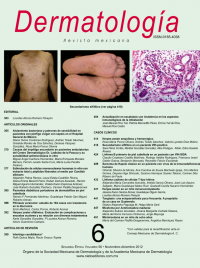RESUMEN
La escabiasis es la infestación cutánea por el ectoparásito Sarcoptes scabiei var hominis. Afecta aproximadamente a 300 millones de personas en todo el mundo y su distribución es cosmopolita; sin embargo, es más común en regiones pobres con hacinamiento. La hembra del parásito reside dentro de un túnel que hace en el estrato córneo de la epidermis, en el que defeca y coloca sus huevos. La forma clásica de la escabiasis se distingue por prurito de predominio nocturno y por túneles, pápulas, vesículas y excoriaciones que predominan en los pliegues interdigitales, las superficies flexoras de las muñecas, los codos, la región periumbilical, los glúteos, los tobillos, el pene y la areola. La forma costrosa se distingue por placas hiperqueratósicas costrosas que tienden a fisurarse y pueden ser localizadas o generalizadas. La respuesta inmunitaria ante el parásito es compleja, y en ella interviene el sistema inmunitario innato y adaptativo; sin embargo, el ácaro es capaz de inhibirla en múltiples puntos. A pesar de esto, a medida que los ácaros mueren en la epidermis, cada vez hay más antígenos disponibles para estimular al sistema inmunitario, lo que a la larga provoca que la respuesta inmunitaria logre vencer la inhibición. Dicha inhibición explica el retraso de cuatro a ocho semanas en la aparición de síntomas que experimentan los pacientes en su primera infestación y permite el establecimiento del ácaro en el hospedero. El diagnóstico definitivo se hace mediante la observación microscópica del ácaro en el material obtenido por raspado de las lesiones clínicamente sugestivas. El tratamiento puede incluir medicamentos tópicos o con ivermectina oral. Palabras clave: Sarcoptes scabiei, escabiasis, citocinas, quimiocinas, serina proteasas, inmunomodulación, ivermectina, permetrina.
Palabras clave: inmunomodulación, ivermectina, citocinas, escabiasis, Sarcoptes scabiei, quimiocinas, serina proteasas, permetrina
ABSTRACT
Scabies is the infestation of the skin by the ectoparasite Sarcoptes scabiei var hominis. It affects approximately 300 million people worldwide and it has a cosmopolitan distribution; however, it is more common in regions with poverty and overcrowding. The female parasite makes a burrow in the stratum corneum of the epidermis in which it defecates and lays its eggs. Classic scabies is characterized by pruritus, which is more intense at night, and by the presence of burrows, papules, vesicles and excoriations mainly in the finger webs, flexor aspects of the wrists, elbows, periumbilical skin, buttocks, ankles, penis and areolar region. Localized or generalized hyperkeratotic, crusted plates that tend to fissure characterize crusted scabies. The immune response against the parasite is complex and it involves the innate and adaptive immune systems; but these mites are capable of inhibiting these responses in various aspects. However, as mites die in the epidermis, there are increasing amounts of antigens to stimulate the immune system and eventually this inhibition is overcome. The inhibition of the immune response explains why there is a four to eight weeks delay in symptom appearance during the first infestation and allows the establishment of the mite in the host. Definite diagnosis is achieved by the microscopic observation of the mite in skin scrapings obtained from clinically suggestive lesions. Scabies can be treated with topical medications or with oral ivermectin. Key words: Sarcoptes scabiei, scabies, cytokines, chemokines, serine proteases, immunomodulation, ivermectin, permethrin.
Keywords: immunomodulation, ivermectin, cytokines, scabies, Sarcoptes scabiei, serine proteases, chemokines, permethrin

